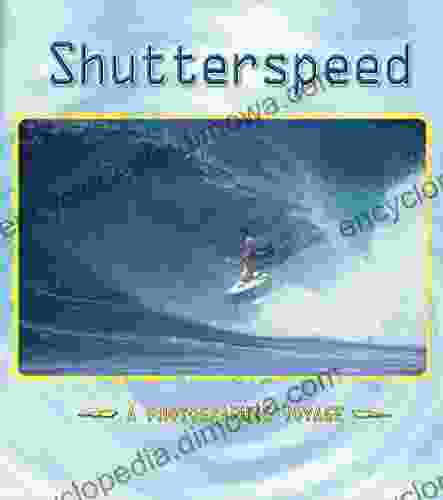Fundamentals of Atomic Force Microscopy Part 1: Your Gateway to the Nanoscale World

Prepare to embark on an extraordinary scientific journey as we delve into the captivating world of atomic force microscopy (AFM). This innovative imaging technique has revolutionized our understanding of the nanoscale, enabling us to visualize and manipulate materials at the atomic level. In this comprehensive guide, Fundamentals of Atomic Force Microscopy Part 1, we will provide you with a solid foundation in the principles and applications of AFM, empowering you to harness its immense potential for research and exploration.
4.2 out of 5
| Language | : | English |
| File size | : | 19296 KB |
| Text-to-Speech | : | Enabled |
| Screen Reader | : | Supported |
| Enhanced typesetting | : | Enabled |
| Print length | : | 342 pages |
What is Atomic Force Microscopy?
AFM is a scanning probe microscopy technique that measures the forces between a sharp tip and a sample surface. By scanning the tip across the surface, AFM can generate high-resolution images of the sample's topography, revealing details down to the atomic scale. This unique capability has made AFM an invaluable tool for materials science, surface characterization, and biological research.
Key Components of an AFM
- Probe Tip: The heart of an AFM is the probe tip, which is typically made of silicon nitride or metal. The tip is mounted on a flexible cantilever, which deflects in response to forces between the tip and the sample.
- Cantilever: The cantilever is a small beam that supports the probe tip. Its stiffness determines the sensitivity of the AFM to forces.
- Scanner: The scanner is a device that moves the probe tip across the sample surface. Scanners can be piezoelectric or magnetic, and they enable precise control of the tip's position.
- Feedback System: The feedback system maintains a constant force between the probe tip and the sample surface. This is achieved by adjusting the scanner's position based on the deflection of the cantilever.
- Data Acquisition System: The data acquisition system records the cantilever's deflection and converts it into an image of the sample surface.
Imaging Modes in AFM
AFM offers a variety of imaging modes, each with its own strengths and applications. The most common imaging modes include:
- Contact Mode: In contact mode, the probe tip is in constant physical contact with the sample surface. This mode provides high-resolution images, but it can also damage delicate samples.
- Non-Contact Mode: In non-contact mode, the probe tip oscillates just above the sample surface. This mode is gentler on samples, but it can provide lower resolution images.
- Tapping Mode: In tapping mode, the probe tip taps the sample surface at a certain frequency. This mode combines the advantages of contact and non-contact modes, providing high resolution without damaging the sample.
Applications of AFM
AFM has a wide range of applications in various scientific disciplines, including:
- Materials Science: AFM can be used to characterize the surface morphology, grain structure, and mechanical properties of materials.
- Surface Characterization: AFM can be used to study the surface roughness, porosity, and other surface properties of materials.
- Biological Research: AFM can be used to image biological molecules, cells, and tissues, providing insights into their structure and function.
- Nanotechnology: AFM can be used to manipulate and pattern materials at the nanoscale, enabling the fabrication of novel devices and structures.
Fundamentals of Atomic Force Microscopy Part 1 has provided you with a comprehensive overview of the principles and applications of AFM. By mastering the concepts presented in this guide, you will be well-equipped to explore the fascinating realm of atomic force microscopy and unlock the secrets of the nanoscale world. Stay tuned for Part 2, where we will delve deeper into advanced AFM techniques and applications.
4.2 out of 5
| Language | : | English |
| File size | : | 19296 KB |
| Text-to-Speech | : | Enabled |
| Screen Reader | : | Supported |
| Enhanced typesetting | : | Enabled |
| Print length | : | 342 pages |
Do you want to contribute by writing guest posts on this blog?
Please contact us and send us a resume of previous articles that you have written.
 Book
Book Novel
Novel Page
Page Chapter
Chapter Text
Text Story
Story Genre
Genre Reader
Reader Library
Library Paperback
Paperback E-book
E-book Magazine
Magazine Newspaper
Newspaper Paragraph
Paragraph Sentence
Sentence Bookmark
Bookmark Shelf
Shelf Glossary
Glossary Bibliography
Bibliography Foreword
Foreword Preface
Preface Synopsis
Synopsis Annotation
Annotation Footnote
Footnote Manuscript
Manuscript Scroll
Scroll Codex
Codex Tome
Tome Bestseller
Bestseller Classics
Classics Library card
Library card Narrative
Narrative Biography
Biography Autobiography
Autobiography Memoir
Memoir Reference
Reference Encyclopedia
Encyclopedia Mirza Rahim Baig
Mirza Rahim Baig Dk
Dk A Alia Zealous
A Alia Zealous Sherri Duskey Rinker
Sherri Duskey Rinker Roger Godement
Roger Godement John Frost
John Frost Sonya Kelly
Sonya Kelly Rebecca Scott
Rebecca Scott Edward G Longacre
Edward G Longacre Travis Booth
Travis Booth Nicola Carroll
Nicola Carroll Brenda Hiatt
Brenda Hiatt H P Blavatsky
H P Blavatsky Forrest Russell Cook
Forrest Russell Cook Iny Lorentz
Iny Lorentz Elizabeth Lucy Ivanecky
Elizabeth Lucy Ivanecky Julian Jan
Julian Jan Mark A Mentzer
Mark A Mentzer Anthony Ambrogio
Anthony Ambrogio Arthur Slade
Arthur Slade
Light bulbAdvertise smarter! Our strategic ad space ensures maximum exposure. Reserve your spot today!

 Alfred RossAnt Plays Bear Penguin Young Readers Level: An Epic Adventure of Imagination...
Alfred RossAnt Plays Bear Penguin Young Readers Level: An Epic Adventure of Imagination...
 Dan HendersonAn Introduction to Distributed Optical Fiber Sensors: Revolutionizing Fiber...
Dan HendersonAn Introduction to Distributed Optical Fiber Sensors: Revolutionizing Fiber... Larry ReedFollow ·18.2k
Larry ReedFollow ·18.2k Jesus MitchellFollow ·6.7k
Jesus MitchellFollow ·6.7k Jerry WardFollow ·11.2k
Jerry WardFollow ·11.2k Jorge Luis BorgesFollow ·11.7k
Jorge Luis BorgesFollow ·11.7k Ronald SimmonsFollow ·13.8k
Ronald SimmonsFollow ·13.8k Asher BellFollow ·10.8k
Asher BellFollow ·10.8k George R.R. MartinFollow ·17.5k
George R.R. MartinFollow ·17.5k Jace MitchellFollow ·14.8k
Jace MitchellFollow ·14.8k

 Zadie Smith
Zadie SmithWork in Early Modern Italy 1500-1800: A Captivating...
: Unraveling the Enigmatic...

 Noah Blair
Noah BlairIceland's Most Unusual Museums: A Quirky Guide to the...
Iceland is a land of natural wonders, from...

 Ross Nelson
Ross NelsonShutterSpeed - A Photographic Voyage
Embark on an Unforgettable Photographic...

 Wayne Carter
Wayne CarterUnveiling the Secrets: Detailed Streamside Field Guide to...
Embark on an unforgettable fly fishing...

 Patrick Rothfuss
Patrick RothfussHannah Montana: Reality Check Junior Novel 19
The Ultimate Behind-the-Scenes Adventure for...

 Chad Price
Chad PriceCreate More Than 30 Projects from Vintage Pieces: Unleash...
Embrace the Art of...
4.2 out of 5
| Language | : | English |
| File size | : | 19296 KB |
| Text-to-Speech | : | Enabled |
| Screen Reader | : | Supported |
| Enhanced typesetting | : | Enabled |
| Print length | : | 342 pages |








